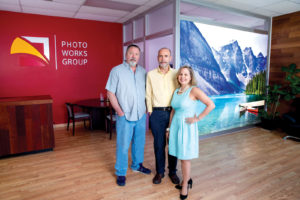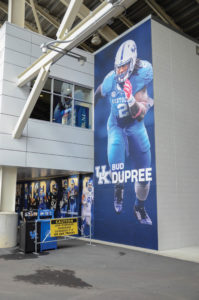 We focus on identifying industries versus just finding customers to generate new business,” says Geoff Kilmer, founder and CEO of PhotoWorksGroup, Charlottesville, Va. “When we specialize in an industry, we become better known within it, which results in more references so we don’t have to sell as hard—and we can concentrate on doing a good job of producing and delivering products.”
We focus on identifying industries versus just finding customers to generate new business,” says Geoff Kilmer, founder and CEO of PhotoWorksGroup, Charlottesville, Va. “When we specialize in an industry, we become better known within it, which results in more references so we don’t have to sell as hard—and we can concentrate on doing a good job of producing and delivering products.”
Kilmer and his wife Denise (executive vice president) launched PhotoWorksGroup in 1986 as a custom lab for commercial advertising photography, with a one-hour mini photo lab in the front of the business to help pay the bills. Now the company creates large-format graphics and fabricated displays made for architectural signage, environmental graphics, interiors and trade shows. The world of photography and graphics has changed significantly since the company’s conception, but Kilmer’s love for photography and the power of crisp, vibrant imaging continue to fuel his passion to keep PhotoWorksGroup on the cutting edge of the industry.
Creating opportunity
The imaging journey began for Kilmer as a child: he had his first darkroom at 10 years old, which his father helped him build. In high school he worked as a photographer, and later joined the U.S. Navy where he served as a Photographer’s Mate. He even met Denise as a result of his love of the art—
she was pursuing her MFA in photography when they met at Rochester Institute of Technology in Rochester, N.Y.
In 1989 the Kilmers purchased a piece of property, built a building and ventured into the exhibit industry. “That was about the time we learned about trade shows and realized we needed a vehicle to leverage our sales versus knocking on doors,” he says. “We realized we could work through the industry.”

and Denise B. Kilmer, executive vice president.
PhotoWorksGroup became a distributor for Nimlok custom modular and portable conference displays and exhibit solutions, which opened doors to custom work for them as well. “As a distributor we went to the exhibitor show (Exhibitor Live) every year in Las Vegas,” he says. “At that time the graphics were still photo optical and there weren’t that many people doing them. Through that affiliation we serviced clients all across the country.”
Before long, digital printing dominated the market, but Kilmer initially stayed with photo optical and tapped into the pharmaceutical industry, making graphics for some of the big-name companies. “The ‘big boys’ in places like New York went with digital imaging because it was so much easier than photo optical work for marketing and advertising,” he says. “But for a period of time photo optical was higher quality than digital imaging. It was a laborious craft, but it took us through the ’90s.”
Competition changed again when ink jet printers came in at the turn of the century. “Suddenly we had competition with sign shops, and the custom exhibit houses that used to buy graphics from us brought their graphics production in house,” Kilmer says. “It wasn’t as complicated as it had been—so we were once again looking for opportunities.”
Riding the dye-sub wave
By 2008 when the recession hit, Kilmer decided to make the move to dye-sublimation printing. “I read articles in trade magazines and went to conferences to better predict market trends and discover emerging technologies and equipment,” he says. “And it was through reading trade magazines that I learned about dye-sub. I decided this time around I wasn’t going to worry about the fact that I didn’t know what was around the corner. I invested in dye-sub equipment, including a 10-foot press with room for growth and a 102-inch printer that could print on transfer paper.”
At the same time, Kilmer identified the airport industry as a promising client base. “The airport industry was predominantly using vinyl at the time, but they were interested in fabric because of the advantages of dye-sub graphics,” he says. “Fabric graphics can be user-installed and swapped out easily. You don’t have to have qualified vinyl installers. The investment in the frame stays with the client so it’s cost-effective.
“There was a period of time in which a lot of airports were switching from vinyl to fabric graphics, so we were on that wave,” he continues.
In addition to adjusting his products to meet industry demands, Kilmer points to another critical component he uses to stay competitive in the graphics industry—he keeps his machines running. “If your equipment is sitting idle, that’s a negative cash flow,” he says. “That’s why the airport industry is so nice,” he says. “It’s a repeating business that replaces graphics annually, quarterly or sometimes monthly.
“There’s more and more competition in dye-sub now, which will drive the cost down,” he continues. “It’s beginning to do that here and it’s already happened in Europe. But in the meantime if you can keep focused on higher end accounts, where you can do some production work, you can make some money. The key is to keep your equipment running.”
Prime clients, prime equipment
Kilmer’s son Benjamin, vice president of development at PhotoWorksGroup, identified the company’s latest industry focus—corporate branding. Products the company provides to that industry include dye-sub, window graphics, vinyl murals, wallpaper murals and a host of other graphic services.
“You need to have the right equipment if you’re going to work in the high-end market, because if you’re working for agencies or high-end companies, when they ask for a PMS (Pantone Matching System) of ‘such-and-such,’ you’ve got to hit it or come darn close to it. And you can’t do that effectively without a good color calibration.”
Kilmer says it’s essential to have a spectrophotometer and RIP software to achieve the quality his clients expect. PhotoWorksGroup uses a Barbieri spectrophotometer to measure the intensity of light absorbed by the substrate, coupled with Caldera RIP (Raster Image Processing) software, which translates the files for the printer. “We bought the two as a package. The spectrophotometer not only reads reflective graphics, it reads backlit graphics as well,” Kilmer says. “The colors sing. They look beautiful—and that quality keeps the clients coming back.”
Although business is good, Kilmer isn’t content to rest in that reality. Each week he takes a little time to look through trade magazines and consider what the next trend might be. “You can’t stand still. You really need to be looking ahead all the time if you want to grow. And from my perspective, if you’re not growing, you’re dying,” he says. “It’s one or the other in this industry because the technology moves so quickly.”
Sigrid Tornquist is a writer and editor based in Minneapolis, Minn., and a regular contributor to the Review.
 Before PhotoWorksGroup CEO Geoff Kilmer decided that dye-sublimation fabric printing was suitable for this 14-foot wide, 32-foot high likeness of former University of Kentucky linebacker Alvin “Bud” Dupree Jr. outside Kroger Field, he inspected the protected outdoor site and confirmed it did not get direct sun exposure. “Dye-sub fabric graphics are very nice for outdoor applications if protected from direct sunlight,” Kilmer says. “They have the advantage of being nonreflective and have a rich look and feel that’s difficult to duplicate with inkjet/vinyl banners, but they are not suitable for permanent outdoor locations with direct sunlight.”
Before PhotoWorksGroup CEO Geoff Kilmer decided that dye-sublimation fabric printing was suitable for this 14-foot wide, 32-foot high likeness of former University of Kentucky linebacker Alvin “Bud” Dupree Jr. outside Kroger Field, he inspected the protected outdoor site and confirmed it did not get direct sun exposure. “Dye-sub fabric graphics are very nice for outdoor applications if protected from direct sunlight,” Kilmer says. “They have the advantage of being nonreflective and have a rich look and feel that’s difficult to duplicate with inkjet/vinyl banners, but they are not suitable for permanent outdoor locations with direct sunlight.”
Kilmer and his sewers used a robust warp knit polyester fabric and sewed a flat gasket on all four sides of four panels. The team used PhotoWorks’ standard lightweight surface mount FabEZE extrusion, and on the horizontal seams they placed the extrusion back-to-back with a gap between them to form an equal width slot for the adjacent panel. “So rather than inserting the edge into the intended slot, we jumped across it and put it in the slot formed by the back-to-back extrusion. This is how we managed the tight seams between the panels,” Kilmer says. “Finally, we drilled holes in the outside edge of the frame and inserted screws to lock the graphic into the frame for protection against high winds.”
 TEXTILES.ORG
TEXTILES.ORG


